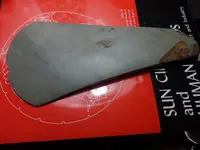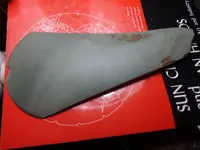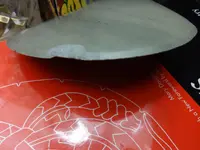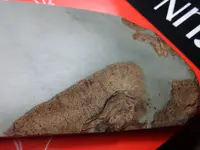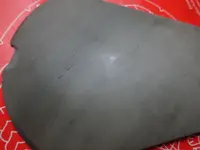You are using an out of date browser. It may not display this or other websites correctly.
You should upgrade or use an alternative browser.
You should upgrade or use an alternative browser.
estate sale find
- Thread starter jamey
- Start date
kcm
Gold Member
- Joined
- Feb 29, 2016
- Messages
- 5,790
- Reaction score
- 7,090
- Golden Thread
- 0
- Location
- NW Minnesota
- Detector(s) used
- Tesoro Silver uMax
- Primary Interest:
- Other
Pretty cool. Looks like slate with a bit of other rock on the thick end.
Looks like someone took a lot of time and care making that edge.
Looks like someone took a lot of time and care making that edge.

jamey
Silver Member
- Joined
- Feb 3, 2007
- Messages
- 3,069
- Reaction score
- 1,924
- Golden Thread
- 0
- Primary Interest:
- All Treasure Hunting
- #4
Thread Owner
no,i asked if there were any artifacts and someone went and brought me this,said he did not know what it was,didnt want much so i bought it thinking its fake.
The Grim Reaper
Gold Member
- Joined
- Apr 3, 2008
- Messages
- 7,805
- Reaction score
- 7,068
- Golden Thread
- 0
- Location
- Southern Ohio
- Primary Interest:
- All Treasure Hunting
I would venture to guess that bit was put on there by a grinder or something similar. Most likely not very old.
Buckleberry
Hero Member
Agreed, I've never seen a bevel quite like that on a celt.I would venture to guess that bit was put on there by a grinder or something similar. Most likely not very old.
joshuaream
Silver Member
- Joined
- Jun 25, 2009
- Messages
- 3,170
- Reaction score
- 4,512
- Golden Thread
- 0
- Location
- Florida & Hong Kong
Did the Marine visit Papua New Guinea during World War 2? Because that's where your piece probably originated from (or from one of the other Pacific Island areas.) I'd guess it was made within the last 150 years or so.
Groups in Papua New Guinea (big island near Australia) still make stone axes and adzes, but basically every rural farmer/hunter used them up until the 1950's or so. I've had a few over the years, they are neat items. Groups there made lots of different styles, pieces like yours, because they are so thin, are probably just decorative examples vs every day tools. The bevel as pointed out is completely wrong for pieces from the US, is completely right for pieces from there. Some are made from a very hard type of greenstone, and that steep bevel is the easiest way to put an edge on it. They use the same technique for making an edge on pieces made from slate/shale and softer stones like yours.
If you are interested in values, let me warn you they aren't that expensive. You'll see some websites where they list them as ancient and sell them for hundreds or even thousands of dollars, but you'll see similar pieces elsewhere for $50. Occasionally you'll see them for sale at auctions or with old papers from the main midwestern authenticators. They started showing up in auctions as WW2 Vets died (80's and 90's), and people assumed they were just really amazing celts found locally where the collector lived. There wasn't a lot of info about them, but they generally sold for very high prices until the internet opened up the world of pictures and information.
Here are some pictures of similar examples, click the picture to see it with more detail. Google Papua New Guinea axe and you'll find pages and pages with the different styles.
Here are some, they are probably oiled up so they look polished. Yours is pretty similar to the middle one, probably similar material, and beveled with that steep bevel.
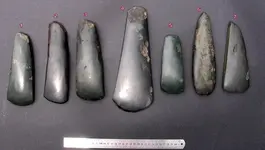
Here is one from an auction site with handle. I think the handle is actually flipped over. The stone head would go at the top of the picture so the woven part would be the tail of the axe.
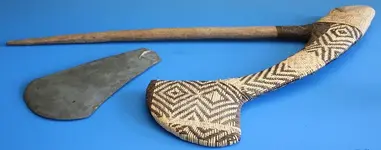
A couple more similar to yours.
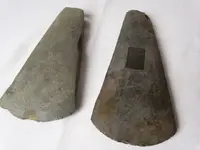
Groups in Papua New Guinea (big island near Australia) still make stone axes and adzes, but basically every rural farmer/hunter used them up until the 1950's or so. I've had a few over the years, they are neat items. Groups there made lots of different styles, pieces like yours, because they are so thin, are probably just decorative examples vs every day tools. The bevel as pointed out is completely wrong for pieces from the US, is completely right for pieces from there. Some are made from a very hard type of greenstone, and that steep bevel is the easiest way to put an edge on it. They use the same technique for making an edge on pieces made from slate/shale and softer stones like yours.
If you are interested in values, let me warn you they aren't that expensive. You'll see some websites where they list them as ancient and sell them for hundreds or even thousands of dollars, but you'll see similar pieces elsewhere for $50. Occasionally you'll see them for sale at auctions or with old papers from the main midwestern authenticators. They started showing up in auctions as WW2 Vets died (80's and 90's), and people assumed they were just really amazing celts found locally where the collector lived. There wasn't a lot of info about them, but they generally sold for very high prices until the internet opened up the world of pictures and information.
Here are some pictures of similar examples, click the picture to see it with more detail. Google Papua New Guinea axe and you'll find pages and pages with the different styles.
Here are some, they are probably oiled up so they look polished. Yours is pretty similar to the middle one, probably similar material, and beveled with that steep bevel.

Here is one from an auction site with handle. I think the handle is actually flipped over. The stone head would go at the top of the picture so the woven part would be the tail of the axe.

A couple more similar to yours.

Last edited:
jamey
Silver Member
- Joined
- Feb 3, 2007
- Messages
- 3,069
- Reaction score
- 1,924
- Golden Thread
- 0
- Primary Interest:
- All Treasure Hunting
- #8
Thread Owner
Joshuarream,you are the reason i put this on here,if anyone knew what it is i knew it would be you.I bought it thinking it was fake,just getting as much as i could,but when i brought it home and really looked at it,i thought it may be something.value does not really matter too me just wanted to know if it may be a real object.the ones who sold it too me did not seem too be dishonest.you are so kind,and love how you share your wisdom with us here on treasurenet.thank you Sir.
The Grim Reaper
Gold Member
- Joined
- Apr 3, 2008
- Messages
- 7,805
- Reaction score
- 7,068
- Golden Thread
- 0
- Location
- Southern Ohio
- Primary Interest:
- All Treasure Hunting
I stand corrected. Thanks Joshua for explaining what it really was. I wasn't off much on the age though. lol
Buckleberry
Hero Member
Still a very cool celt, hope it's from New guinea, I really like how there's still 'cortex' on it, adds character.
joshuaream
Silver Member
- Joined
- Jun 25, 2009
- Messages
- 3,170
- Reaction score
- 4,512
- Golden Thread
- 0
- Location
- Florida & Hong Kong
I stand corrected. Thanks Joshua for explaining what it really was. I wasn't off much on the age though. lol
Steve, you figured out more than a couple of the authenticators from Kentucky that papered those celts for a while.
Bow Only
Sr. Member
- Joined
- Jun 20, 2016
- Messages
- 253
- Reaction score
- 485
- Golden Thread
- 0
- Primary Interest:
- All Treasure Hunting
Something about this piece makes me want to say it is authentic. Look at the bit very closely under magnification. That will help determine how it was made. Uni-directional marks fairly parallel would help reinforce the use of grinder.
Similar threads
- Replies
- 61
- Views
- 6K
- Suggestion
- Replies
- 13
- Views
- 946
Users who are viewing this thread
Total: 1 (members: 0, guests: 1)

